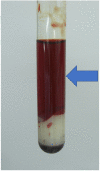Clinical and Microbiological Features of Fulminant Haemolysis Caused by Clostridium perfringens Bacteraemia: Unknown Pathogenesis
- PMID: 37110247
- PMCID: PMC10143116
- DOI: 10.3390/microorganisms11040824
Clinical and Microbiological Features of Fulminant Haemolysis Caused by Clostridium perfringens Bacteraemia: Unknown Pathogenesis
Abstract
Bacteraemia brought on by Clostridium perfringens has a very low incidence but is severe and fatal in fifty per cent of cases. C. perfringens is a commensal anaerobic bacterium found in the environment and in the intestinal tracts of animals; it is known to produce six major toxins: α-toxin, β-toxin, ε-toxin, and others. C. perfringens is classified into seven types, A, B, C, D, E, F and G, according to its ability to produce α-toxin, enterotoxin, and necrotising enterotoxin. The bacterial isolates from humans include types A and F, which cause gas gangrene, hepatobiliary infection, and sepsis; massive intravascular haemolysis (MIH) occurs in 7-15% of C. perfringens bacteraemia cases, resulting in a rapid progression to death. We treated six patients with MIH at a single centre in Japan; however, unfortunately, they all passed away. From a clinical perspective, MIH patients tended to be younger and were more frequently male; however, there was no difference in the toxin type or genes of the bacterial isolates. In MIH cases, the level of θ-toxin in the culture supernatant of clinical isolates was proportional to the production of inflammatory cytokines in the peripheral blood, suggesting the occurrence of an intense cytokine storm. Severe and systemic haemolysis is considered an evolutionary maladaptation as it leads to the host's death before the bacterium obtains the benefit of iron utilisation from erythrocytes. The disease's extraordinarily quick progression and dismal prognosis necessitate a straightforward and expedient diagnosis and treatment. However, a reliable standard of diagnosis and treatment has yet to be put forward due to the lack of sufficient case analysis.
Keywords: Clostridium perfringens; bacteraemia; massive intravascular haemolysis (MIH).
Conflict of interest statement
The authors declare no conflict of interest.
Figures
References
-
- Van Bunderen C.C., Bomers M.K., Wesdorp E., Peerbooms P., Veenstra J. Clostridium perfringens septicaemia with massive intravascular haemolysis: A case report and review of the literature. Neth. J. Med. 2010;68:343–346. - PubMed
Publication types
LinkOut - more resources
Full Text Sources



